
Original Link: https://www.anandtech.com/show/2675
Digital Cameras for the Holidays
by Wesley Fink on November 27, 2008 12:00 AM EST- Posted in
- Digital Camera
2007 turned out to be the year of the Digital SLR, just as many predicted. Industry shipments confirm the huge growth in Digital SLR sales in 2007, and that growth continued through most of 2008. Many believed the slowing economy would have no impact at all on the growth of DSLR sales; however, the last couple of months have seen lower growth than expected.
That news means there will be many bargains in current Digital Camera models over this holiday season. Year-end is always a time of bargains, but they are usually last year's models. This year you will likely see sale prices on the latest and greatest. That's good news if you're in the market for a new digital camera this year.
There are also bargains galore on low-end point-and-shoot digital cameras. As prices have fallen on DSLR cameras it has pushed the P&S prices even lower. For the first time we've found a couple of point-and-shoot cameras we can easily recommend that are selling for around $100. You will also find recommendations for good values in the Superzoom category. Bigger sensors (larger size, not higher resolution) are coming to the P&S market and that development is already having an impact.
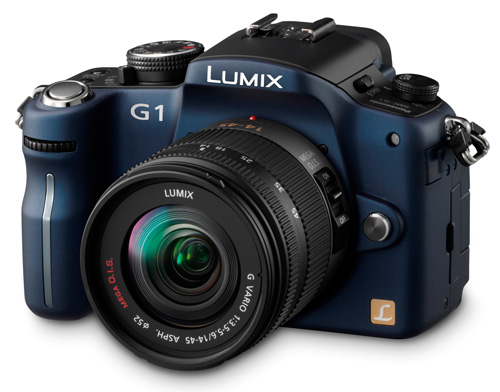
We have also been enjoying our time with the new micro 4/3 Panasonic G1. This interchangeable lens digital is not an SLR, but it is likely to become the poster child for what's coming in the midrange "DSLR" and Point-and-Shoot space. Very few things are truly revolutionary in electronics, let alone the slower paced digital camera market. The Panasonic G1 is truly revolutionary, as you will see in our recommendations in entry and midrange interchangeable lens cameras.
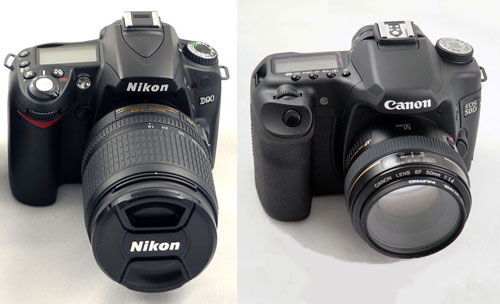
With the introduction of the Nikon D90 and Canon 50D, the advanced amateur or "prosumer" market is finally complete for a few months. This recommendation always generates the most comments as buyers loyal to one camp or another question our picks for the buyer's guide. With so many competent DSLRs in this segment this year, the choice was difficult.
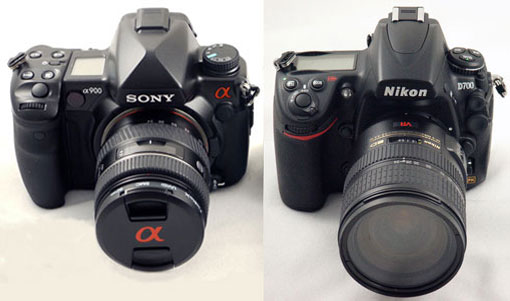
With the three biggest players all with full-frame (35mm size sensor) models at the top, it should be crystal clear that our prediction last year that full-frame become would become the camera of choice in the pro market has certainly come true. It happened even faster that we thought, and there are now 5 full-frame DSLRs with more on the way. Three very different models now compete at $3000 or less in a market first carved out by Canon. It's fair to ask if anyone can price a full-frame DSLR at $8000 any more?
If you are shopping for a digital camera but you're not really a photo hobbyist, you might want to start with our overview of digital photography in Digital Photography from 20,000 Feet. If you want to delve a little deeper you really need to know more about the digital sensor, an analog device that is the heart of any digital camera. Take a look at our two part series on the Digital Sensor in The Digital Sensor: A Guide to Understanding Digital Cameras and The Digital Sensor: Part 2.
Entry Digitals
The entry Point-and-Shoot market is toughest of all to navigate. Every company seems to pile on more hype - most of which is meaningless - in an effort to persuade the unknowing into buying their camera. Before we make our recommendations, let's talk about a few things to avoid.
Digital zoom is totally meaningless and does nothing for your photos. It means either the camera chooses high ISO in low light or that the camera crops the picture it takes and digitally stretches the result to make it appear that it zoomed. Neither one does anything good for your pictures. The only zoom that matters is optical zoom, which is the zoom range of the fixed lens.
Image Stabilization - or IS, Mega OIS, VR, and other names - is important. Image Stabilization allows you to hand hold the shot in lower light than normally possible. This is very important with P&S since the tiny sensors always compromise ISO "film" speed and low light performance. Look for this feature as it makes a difference in the quality of the pictures you take.
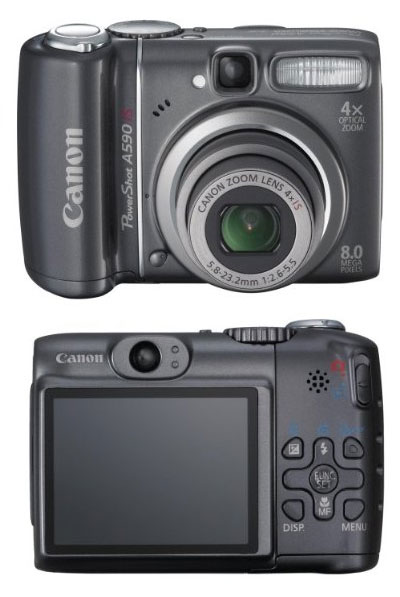
For just over $100 you can buy the Canon Powershot A590 IS. The A590 lists for $149, and it's worth it, but a little shopping will find you an even better price. The A590 features IS (Image Stabilization), a very good quality 4x zoom lens (35-140mm equivalent), and a bright 2.5" LCD in an 8.0MP dark graphite body. It features the latest in face detection and motion detection technology and produces good quality images in full auto mode or the wide selection of scene modes that work well in tricky lighting.
Experienced users, or those who want to grow with their camera, will appreciate the range of control from all Auto to adjustable ISO, color, contrast, white adjustment, and sharpness/saturation. You also get Program, Aperture Priority, Shutter Priority, and full Manual , which is very rare in an entry level point-and-shoot. In addition to the 4x optical zoom there is an added 4x digital zoom that works better than most, but keep in mind that digital zoom is of much more limited use than true optical zoom.
The A590 is small but not tiny. In the end it delivers great images right out of the box in full auto mode - there's even an easy mode for complete beginners. When you want more, there is a very wide range of adjustments you can grow with. "Film" is SD or SDHC cards and power is two AA batteries - not bad for a camera that costs just over $100.
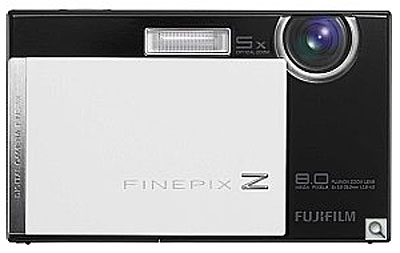
Some prefer a really tiny camera that fits easily in a purse, pocket, or backpack. A good choice for those who like thin and small is the Fuji Z100FD. This tiny camera actually packs a 5x (36-180mm) optical zoom and an 8.0MP sensor in that tiny body. It also delivers an excellent image for the cost of around $119 if you shop for it. It achieves super small size by using a small rechargeable Li-Ion battery and comes with the battery and charger. It does away with the optical finder to keep things small, but the LCD is a large 2.7". The Z100FD is also the first Z series to feature Image Stabilization and Automatic Red-Eye Removal.
The Z100FD is available in Shell Pink, Cappuccino Brown, and Tuxedo Black in addition to the standard Satin Silver. The colors will likely be a hit for those who want to tuck it in their purse, but you may have to pay more for colors other than Silver. When it was introduced, the Fujifilm Z100FD had a suggested price of $249, but it has dropped to $199 and can be found today at $115 to $120 at large etailers like Newegg and BuyDig.
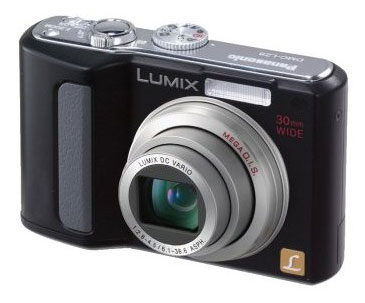
Another excellent choice in the beginner P&S category is the Panasonic Lumix DMC-L8. This 8.1MP model features a 5x (32-160mm) optical zoom lens and an exceptionally wide ISO range of 100-6400. Other features are definitely competitive with the best in this category.
If you are wondering why all our choices are around 8MP, it is because of the tiny sensors used in point-and-shoot cameras. 8MP seems to be the sweet spot for current P&S sensors. You can still achieve a wider usable ISO range and keep noise reasonably low. When you go beyond 8MP with these small sensors, image quality deteriorates very fast. Our advice here is to avoid the 12 to 15MP point-and-shoots and stick to 7 to 9MP for best overall performance.
Superzooms
When point-and-shoot was king of the digital market and the Digital SLR was only in the hands of the pros, there were all kinds of sub-segments in the point-and-shoot market. However, today the lines have become so compressed with DSLR prices dropping that there are really just two P&S categories. There is the entry, or all-around, point-and-shoot and the superzooms, with very wide optical zoom lenses.
Our strong opinion is that it is ludicrous to spend more than around $250 for a point-and-shoot camera today, with the prices of the much more versatile DSLR and the new category interchangeable lens digital starting at $400 to $500. That still leaves a hole from about $250 to around $600 that we think will get quickly filled with large sensor point-and-shoots using micro 4/3 and interchangeable lens mirrorless cameras based on similar large sensor technology.
For those reasons, we have held our top picks for superzooms to around $250. You can certainly spend more if you want that 18X Leica zoom on the Panasonic Lumix DMC-LZ18, but you won't find that camera in our superzoom picks.
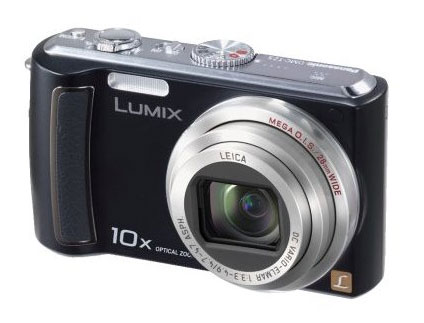
Panasonic has developed a well-deserved reputation as a premier provider of superzoom P&S cameras. The Panasonic Lumix LMC-TZ5 is a great successor to the best-selling LMC-TZ4. It features the same superb Leica 10X (28-280mm) true wide-angle zoom as the TZ4, and resolution has been upped a bit to 9.1MP. Every feature Panasonic could think up has been lavished on the TZ5, including Mega OIS stabilization, 3" 460,000 pixel LCD, a very wide 100-6400 ISO range, and a 720p (1280x720) movie recording option.
The TZ5 has a wide range of Auto and Scene modes for excellent flexibility. However, like the previous models, Panasonic has not included Manual controls, so the TZ5 is clearly aimed at the point-and-shoot crowd only. We doubt that many will object. The TZ5 has no viewfinder and does everything on the LCD, which may or may not matter to you. For a little less money, you can find the capable TZ4 with 8MP or a little more money will get you the 18x 10MP TZ28.

Canon point-and-shoot cameras have a reputation for very good image quality, and the Canon SX110 IS won't disappoint you. This update to Canon's SX100 IS ups the resolution to 9MP and the screen from 2.5" to 3". The 10X zoom goes longer than the Panasonic at 36-360mm, but it is missing the true wide-angle that is very useful for shooting indoors. Where the Canon shines, however, is in control, where it offers P, S, A, and Manual options and everything you need to control the camera when you choose.
The Image Stabilization is particularly effective on the SX110 IS, which is a good thing because you will need it to handhold 360mm. You can usually find the SX110 IS a little cheaper than the Panasonic DMC-LZ5, so if lowest price is a huge factor the SX110 IS can save you a few dollars.
Entry Interchangeable Lens
Why should you spend more money for a DSLR than a point-and-shoot camera, when resolutions appear similar and the point-and-shoots offer the same features? It's all about the sensor and flexibility. The senor is an analogue device that converts light to a digital signal, so the larger the light gathering points (pixels) the more the ability to gather light and distinguish fine detail. The DSLR sensor is at least ten times larger than the typical P&S, so it can gather more light and resolve finer variations in that light. This means the image quality will be better with a DSLR and the sensor is capable of providing good images over a much wider range of light conditions than a P&S.
This category also features interchangeable lenses so you can choose to mount a wide variety of lenses designed for certain purposes - fast speed for low light, fast telephotos for sports, long telephotos for bird-watching, super wide-angle for sweeping landscapes, etc. The category name had to be changed this year to make way for a brand new category of digital camera. The Panasonic G1 is the first, but likely just the beginning, of the interchangeable lens digital camera without a mirror-box. That means it is not an SLR, but it does compete in the DSLR market space.

A Panasonic G1 recently landed in the lab, and we are mightily impressed. The descriptions of this little mirrorless interchangeable lens digital camera intrigued us, as they did everyone, but in the flesh the G1 is even more revolutionary and impressive.
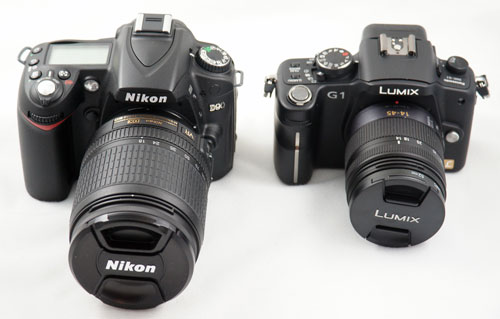
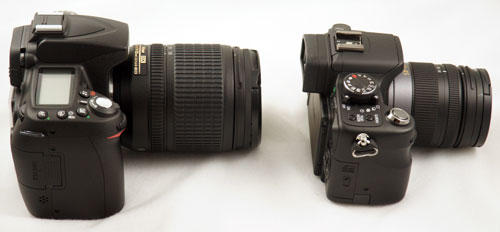
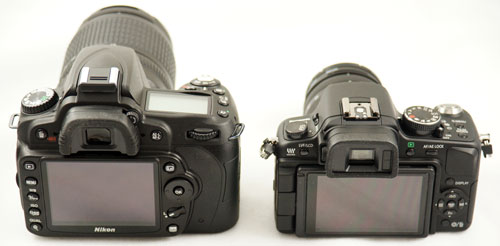
You can see how small the G1 really is side-by-side with the new Nikon D90. There is the potential for micro 4/3 to go even smaller. The tiny 14-45mm zoom (28-90mm equivalent) really sets the size standard around which the 4/3 system will be built. What the pictures can't show is that while the G1 is small it does not feel cheap or too tiny in the hands. Ergonomics are very good, and the rubberized covering of the body will be loved by most and hated by a few.
The 23-point contrast detect AF is remarkably fast, so you can forget about Live View AF as a limitation - because it is fast on the G1, as fast as an optical DSLR with good phase-detect focusing. The view on the flexible 3" tilt-and-swivel LCD is very bright and clear, and as big as it gets in this class. The detail, with a 420,000 pixel screen, is better than anything else in its category.
The viewfinder is also electronic, but it's not like any of the limited EVF finders we have seen in the past. In most situations you have to remind yourself that this is an EVF, since the view is bigger and brighter than the normal DSLR with a pentamirror. It only gives itself away in very low light where the EVF becomes gritty and tears, but otherwise it is not a handicap at all.
There's lots of good news with the G1, but there is also the price. After using a G1, I understand the pricing at $795 - because it can easily compete in the prosumer class and $795 is a bargain in that space. However, that is not where the G1 will compete. It will be trying to grab market share from entry DSLRs where a $500 price is more appropriate. Fortunately, we already see dealers on eBay selling the G1 kit for $649 to $695. Special promotions like Microsoft Live Search cashback can reduce the price another 25%, getting the eBay final cost down to around $500, where the G1 is an incredible value.
The G1 by itself is good enough to compete in the prosumer market, and that says a lot. However, the micro 4/3 lens system is not here yet. Until there are more choices in micro 4/3 lenses and more 4/3 lenses that work completely on micro 4/3, the system can only be viewed as entry. The potential is certainly there, and as it is the G1 is an easy choice as an entry camera recommendation. You will see more about the G1 in an upcoming review.

In looking at a traditional DSLR in the entry class, the first consideration has to be value. As you saw in Sony A200: Entry DSLR Roundup, the Sony A200 stands out as a great value in a crowded field. The A200 inherits the sensor and electronics refinements of the A350/A300/A700 in a package that updates the A100, a camera originally designed to sell for twice the price of the $499 A200.
The 10.2MP A200 has faster AF than the A100, a larger 2.7" LCD, faster image processing, and more robust adjustment ranges. It also shares an optional battery grip with the A300/A350, correcting an omission on the A100. Neither the Nikon D60 or Olympus E420/E520 offer a battery grip option. The in-body image stabilization, is even more effective on the A200 and it works with any lens you can mount on the camera.
The Sony A200K, which includes the 18-70mm lens, is widely available for $499 or less. However, the 2-lens A200W is the real bargain right now with Sony instant rebates. You can get the two-lens kit, with the addition of the 75-300mm zoom, for around $549 at Amazon and other large etailers. The second lens normally adds $200 to the kit price.
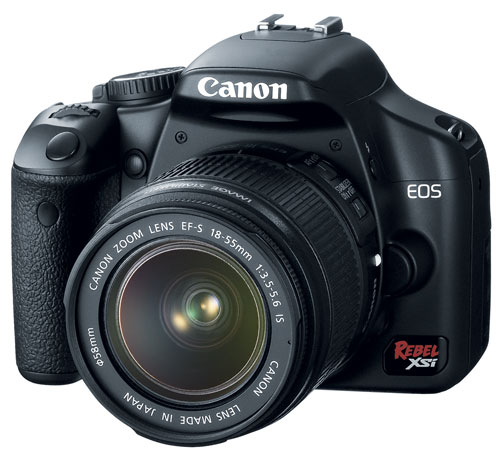
You can never go wrong buying Canon or Nikon as your first serious camera, and it turns out the Canon XSi remains one of the best buys in the Canon line. The XSi price has dropped quite a bit since it was introduced and you can now find this superb 12.2MP camera for $650 or less with the Cannon 18-55mm IS (Image Stabilized) lens. Canon IS is in the lenses and not in the camera body, so you will need to buy IS lenses for that feature.

If every penny counts, as it does for many in these economic times, the 10MP Canon XS provides most of the XSi features in a cheaper package. The XS with the 18-55mm IS lens is selling for around $499, which is the same price as the Sony A200.
Both the XSi and XS feature Live View, which lets the user use the LCD to compose and focus pictures. This is a feature that is missing on the Sony A200. However, Live View focusing is very slow on most of today's DSLR cameras, with the exception of the Sony A300/A350, which feature Live View on a tilt LCD as their primary shooting mode. If Live View interests you, check out these two Sony models as well. The Panasonic G1 is also a Live View camera, but the fast 23-point Live View AF and flexible, accurate tilt-and swivel 3 inch LCD make it a no-compromise Live View solution.
Prosumer Picks
Photo hobbyists usually have an investment in a particular lens line and that influences their buying decision. It also seems emotions run high among photography hobbyists, so any hard recommendation in the prosumer area invites a stoning from fans of other systems. However, we like to think we are objective and some recent introductions have reshaped value in the prosumer space.
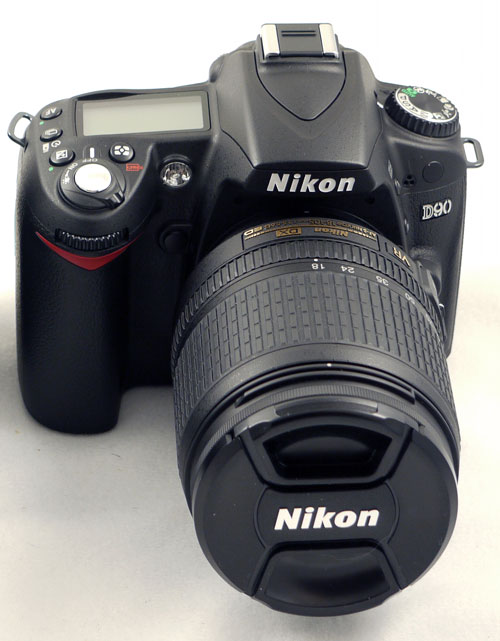
Nikon pulled out all the stops with the new D90. It basically features the same 12.3MP CMOS sensor as the Sony A700 and Nikon D300 with updated image processing. However, the starting price is $999 and not $1395 or $1795. That will deliver a lot of value to the Prosumer segment.
Nikon lavished most of the features of the D300 on the new D90, including the 3" 920,000 pixel hi-res LCD used on the D300 and Sony A700. The only major exception is the 51-point AF module unique to the D300 and A700/D3; the D90 merely has a fast 11-point AF. Also new to the D90 and missing from the D80 are two flavors of Live View and Auto Sensor Cleaning. Image processing has been borrowed almost in total from the D300 with both cameras now featuring Nikon's Scene Recognition System, and D-Lighting for expanded dynamic range. Continuous shooting speed also jumps to 4.5 FPS from the 3 FPS of the D80.
Nikon also introduced a new standard lens with the D90 in the 18-105mm VR AF-S. The new normal zoom is arguably the best image quality of Nikon's current selection of crop-sensor normal lenses. Last, but not least to some buyers, the D90 features a Movie Mode - a first in this class. Unfortunately, auto-focus is not active in the movie mode so this feature was of limited use in our testing. However, it will be a nice option for shooting subjects that stay in place and don't move much - like still life. In total the D90 is a great value in the prosumer class and hard to beat.
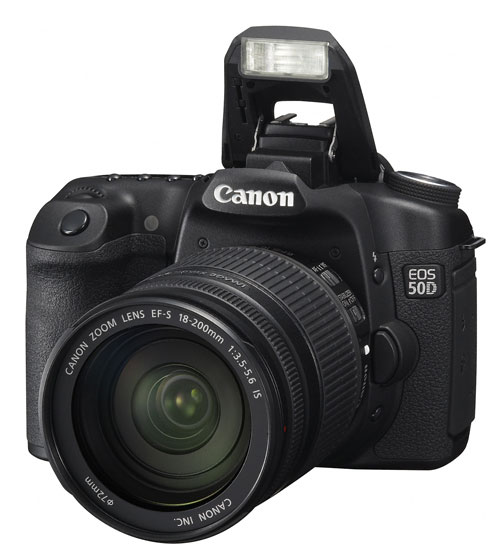
The new Canon 50D moves Canon to the top of the class in crop-sensor resolution again with a 15.1MP sensor and an incredibly wide range of ISO adjustments to ISO 12800. However, resolution tests show about the same results as the 12.3MP Nikon D90, D300, and Sony A700. Noise also increases a bit with the more densely packed sensor, resulting in no real gain in noise-reduction at the top, and a slight reduction in dynamic range compared to the competition.
The 50D does feature a 920,000 dot LCD, which is a significant improvement over the 40D 3" low-res screen. Image processing is also sped up with a Digic 4 processor. While the list price is $1395 for body only, the 50D is currently selling for around $1200.

Canon continued the 40D in their product line and the 10.1MP 40D has become a super value in this class. If you want a top advanced amateur camera but price is a concern, you can find the 40D selling for $799 to $849, which is an excellent value.
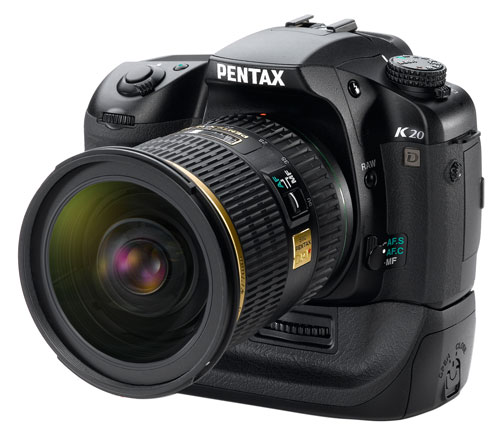
Another great value in prosumer cameras is the rugged, pro-sealed Pentax K20D, which is now selling in the $750 to $800 price range. Resolution is a very high 14.6 megapixels, but noise and color shifts can become an issue at higher ISOs. AF speed is not the fastest and neither are continuous frame rates, but as a high resolution photo tool with a huge offering of Pentax AF lenses the K20D is an outstanding value.
If you want a more rugged pro Nikon body, 51-point AF, and a few more features - at a higher price - the Nikon D300 is a good choice. The Sony A700 uses the same Sony 12.3MP sensor as the D300, and it is very fast and capable. Sony has been running a $300 off special pricing recently, presumably because a replacement model is expected at PMA early next year. The A700 lacks any kind of Live View if that feature matters to you, but Live View is pretty basic and very slow in most of the DSLR competition so it is more a checklist feature than truly useful.
If you are an Olympus fan, you will need to wait for a couple of months. Olympus has announced the new 12MP E30 that brings most of the great E3 features, including its super fast AF module, down to a lower prosumer price point. The E30 will not ship until early 2009.
Full-Frame DSLRs
Just over a year ago we were predicting that the professional DSLR market would likely move completely to the full-size digital sensor. The speed with which this has actually happened is pretty impressive. A little over a year ago only Canon played alone in the full-frame arena, and their top selling full-frame pro model, the 1DS Mark II, was selling for $8000. Now just over a year later the top three camera manufacturers - Canon, Nikon, and Sony - all have full-frame offerings, and all of them have full-frame models that sell for $3000 or less.
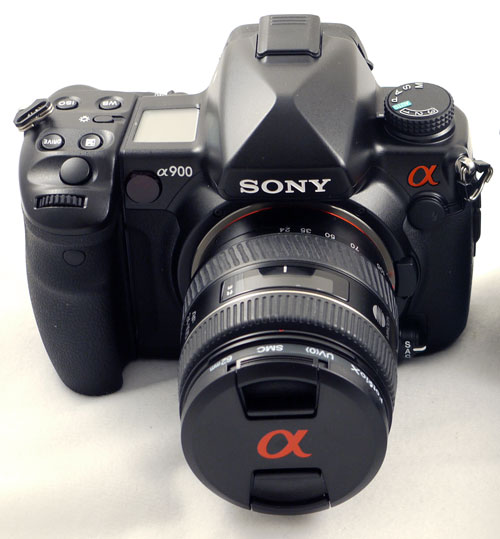
Since acquiring Minolta, Sony has been aiming for more respect in the camera industry. A key part of that strategy was the launch of a full-frame Sony DSLR, which finally happened in the last couple of months. The new Sony A900 is not just another offering either, but a new full-frame solution. First, it features the highest resolution full-frame sensor you can buy with the 24.6MP Sony sensor. Pundits said Sony couldn't make a full-frame with Image Stabilization in the body, but that is exactly what they did. Steady Shot works great and makes any of the multitude of Sony and Minolta lenses that mount on the A900 image stabilized.
There is also the viewfinder. If anyone doubted Sony in the optics department they have only to look through the 100% view of the A900 viewfinder to be reminded again what optics and full-frame are all about. In fact, the Sony viewfinder is clearly the best, biggest, and brightest you will find in any current DSLR.
The A900 is not without its issues, however. 24.6MP is an incredible amount of detail, but noise starts to become a problem at ISO 1600. Everyone would like to see lower noise at the higher ISOs, but the detail captured at the highest ISOs, even with higher noise, is still very impressive. Sony has a huge lens lineup, mostly brought over direct form Minolta, but many of these designs could use a refresh. Also in terms of continuous speed, Sony, with all their mirror innovations like parallel link, still falls in the middle at 5 FPS between the super-high speed 9 FPS D3 and the new 3.5 FPS Canon 5D Mark II.
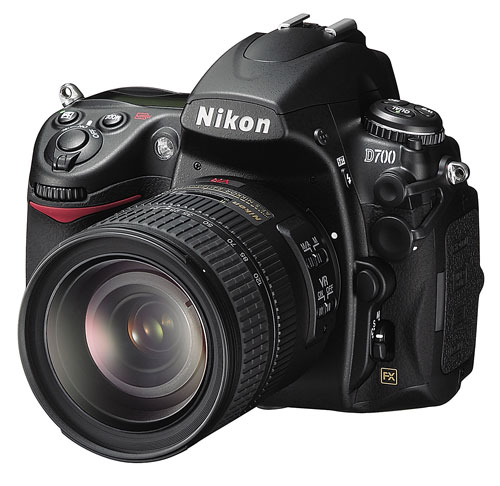
The Nikon D700 is the new cheaper Nikon full-frame designed to compete with the Sony A900 and the Canon 5D Mark II. When it launched just a few months ago it had no real peers, but now that the 24.6MP Sony A900 is shipping and the Canon 5D Mark II is 21.1MP, the Nikon line is starting to look like a new full-frame should be on the way. Nothing we have tested rivals the incredible low noise of the Nikon sensor, and D700 speed with the right battery is a blistering 8 FPS.
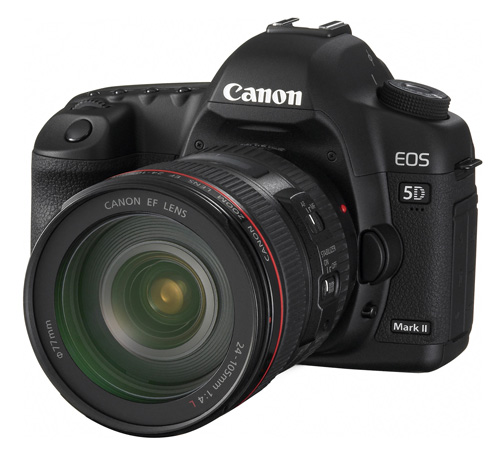
On paper, the Canon 5D Mark II looks like the one to beat in this category. After all Canon was first to offer a full-frame at the low price of around $3000 over three years ago, and Canon themselves proclaim the new 5D Mark II sensor the most advanced they make - better even than the $8000 1Ds Mark III. After the 50D failed to impress as completely as many expected of a 15.1MP Canon, most are waiting until the 5D Mark II production models start landing next week to decide how good they are.
The 5D Mark II updates everything to the very latest thinking in digital technology, including the two Live View modes, and a new twist that will likely be just the beginning of a revolution in the DSLR market. The Canon 5D Mark II also features a true 1080i HD movie mode that is pretty impressive in the early samples Canon has released. This true HD movie capability also auto-focuses. 21.1MP on a full-frame sensor means much bigger pixels than 15.1MP on a 1.6X crop sensor, so high hopes abound. Canon had the guts to include 25600 as an ISO speed option on the new 5D, matching the Nikon D3 and D700 in top ISO speed. If it is close to as good as the Nikon full-frames at high ISO it will not be long until you will see a Nikon D3x. You can be sure a Canon 1Ds Mark IV is also on its way early next year.
It is impossible to make a recommendation in the full-frame category because each camera in the group excels in different areas, and the decision will be based on your needs and the lens system you now use or choose. The Sony delivers the highest resolution any reviewer has ever tested, speed is good, and the viewfinder is the best. Ergonomics and ease-of-use are superb, but it is weak in high ISO noise at this point - which possibly will be much improved (as in the A700) with future firmware updates. The Nikons have the best High ISO performance and speed, but with half the resolution of the Sony A900. Still, for action or sports nothing comes close to the speed of the Nikon full-frames. The Canon 5D Mark II is the slowest of the group on continuous speed, but resolution may come close to the Sony and high ISO performance could be equal or near the Nikon full-frames.
We will soon have more answers to the question of which full-frame is "best", but the market niches that each of these three target will still likely make them three very different solutions for the full-frame market.
Things to Consider
Readers have been screaming that we are ignoring photo beginners and the point-and-shoot crowd. We hope that this year those readers no longer feel ignored. It's amazing to us how fast the P&S market has dropped in price and consolidated features. That made it much easier to find and recommended the $100 choices and the superzoom point-and-shoots. If you have suggestions for future recommendations, we would welcome hearing from you.
Last year when we looked at the DSLR market we commented, "It certainly appears that the DSLR camp is going to be split by manufacturers in the near future to full-frame pro models and APS C entry to prosumer models. This will require companies to support two lens lines with some overlap, but the pros will win this one and we will still be using mainly 35mm glass for quality results on the APS C cameras. There will be cheaper 'small sensor' lenses, as there now are, but perhaps fewer of these in the future."
The split has happened and we have a pretty clear delineation these days of the full-frame and crop-sensor markets. We did not see it coming last year, but there is also change coming from the bottom of the market in the next couple of years. In case you missed it, we are firmly convinced that the Panasonic G1 is truly revolutionary and will bring dramatic change to both the point-and-shoot and DSLR markets. The large sensor point-and-shoots are coming and they will push up into the DSLR market with new models without mirror boxes, new smaller lenses, and a Live View and easy Movie Mode that will push even higher into DSLR space.
Panasonic has proved with the G1 that you can take today's point-and-shoot features like Live View that all DSLRs are now featuring, rework it so it's faster and more useful, and make that feature palatable and desirable to real DSLR photographers. That means we will see new cheaper and smaller lenses at the middle, pushing their way up into prosumer DSLR space. That could also mean a lot of new lenses in new form factors - with current lens offerings from the current DSLR players just moving up the food chain.
Then there is the subject of movies on the DSLR. One industry analyst believes all pros will be shooting mainly HD video on interchangeable lens DSLRs within 2 years. Editors will grab frames they want for "still media" from the HD movie clips the pros shoot. That's a pretty wild prediction - or is it? Perhaps the Canon 5D Mark II is just the beginning of a deluge.
One thing we can be sure of is that the lines between image and electronics are getting ready to go through a major blurring in the next few years. What is now a camera, or a DSLR, or a movie camera, or lenses, or optics, are about to change in definition faster than we can think of new ways to use the evolving technology. Photo purists who complain about things like noise reduction on a Sony sensor or image processing chips in Panasonic cameras that correct for lens distortion are likely to find some of these changes very frustrating. This level of upheaval is always a time of frustration as things we know change very rapidly.
By this point, we hope we have shed some new light on your holiday shopping for a digital camera. Our recommendations may not be popular with some, but we have personally spent time with every camera discussed in this guide and we call them like we see them. Have fun shopping for the best buy in a digital camera this holiday season - whether your treasure is a $100 point-and-shoot or a $3000 full-frame DSLR.
There are many great buys out there and you will likely see lots of super prices as manufacturers fight for market share in this worldwide economic slowdown. Performance is good enough on most of these entry cameras that you would not be wrong to shop for the best price you can find in a category. Just make sure you ask the right questions to get exactly what you want. Whatever you choose, be sure to take lots of digital pictures of your family and friends opening their Holiday presents.
Happy Holidays from AnandTech!







